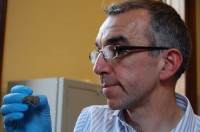 The Yorkshire Museum has launched a campaign to raise the £2,000 ($3111) needed to purchase a rare silver gilt livery badge in the form of a boar. The tiny piece is barely more than an inch high and just under one and a half inches wide, but it was commissioned by King Richard III and was worn by someone of consequence among his supporters, maybe even a member of his household.
The Yorkshire Museum has launched a campaign to raise the £2,000 ($3111) needed to purchase a rare silver gilt livery badge in the form of a boar. The tiny piece is barely more than an inch high and just under one and a half inches wide, but it was commissioned by King Richard III and was worn by someone of consequence among his supporters, maybe even a member of his household.
Richard ordered that 13,000 boar badges be made for his son Edward’s investiture at York Minster in 1483, but despite this large number few have actually been found in this region. Similar items found across the country are made of cloth or copper, but for those of status more precious metals would be used, such as silver in this instance.
 Another silver gilt boar badge was discovered on the site of the Battle of Bosworth Field in the winter of 2009’s discontent. Its find was considered by some archaeologists to pinpoint the precise spot where Richard III lost his horse and made his last stand before succumbing to death and defeat. That boar is now on display at the Bosworth Battlefield Heritage Center.
Another silver gilt boar badge was discovered on the site of the Battle of Bosworth Field in the winter of 2009’s discontent. Its find was considered by some archaeologists to pinpoint the precise spot where Richard III lost his horse and made his last stand before succumbing to death and defeat. That boar is now on display at the Bosworth Battlefield Heritage Center.
The one the museum wants to buy may not have played so Shakespearean a part in earth-shaking historical events, but it was found by a metal detectorist in a cultivated field near Stillingfleet, North Yorkshire, in 2010. The museum wants very much to keep it in the county where it was discovered, a county which of course is intimately connected to Richard III, last king of the House of York. His son’s investiture as Prince of Wales took place in the palace of the Archbishop of York. Richard planned to be buried in the cathedral of York Minster. Had he not died in battle at Bosworth leaving his corpse to the untender nonmercies of Henry Tudor, he would have been the first English king buried at York Minster.
 This badge seems to be more complete than the Bosworth one. It has two intact legs and a haunch (Bosworth’s has one complete leg and three stumps) and the attachment loop on the back (Bosworth’s just has the rectangular solder patch where the loop was once attached). More of the gilding also appears to have survived.
This badge seems to be more complete than the Bosworth one. It has two intact legs and a haunch (Bosworth’s has one complete leg and three stumps) and the attachment loop on the back (Bosworth’s just has the rectangular solder patch where the loop was once attached). More of the gilding also appears to have survived.  The badge hasn’t been cleaned yet, but you can clearly see the glint of gold on the boar’s tail and impressive genitalia.
The badge hasn’t been cleaned yet, but you can clearly see the glint of gold on the boar’s tail and impressive genitalia.
The Yorkshire Museum wants to find out who owned the badge by researching prominent, wealthy supporters of Richard III who lived in or around Stillingfleet. If they can’t narrow down the list to one person, at least they can discover a few likely candidates.
The museum must raise the funds by September or the finder will have the option of selling it to the highest bidder. If you’d like to chip in, click the donate button on the Yorkshire Museum page.